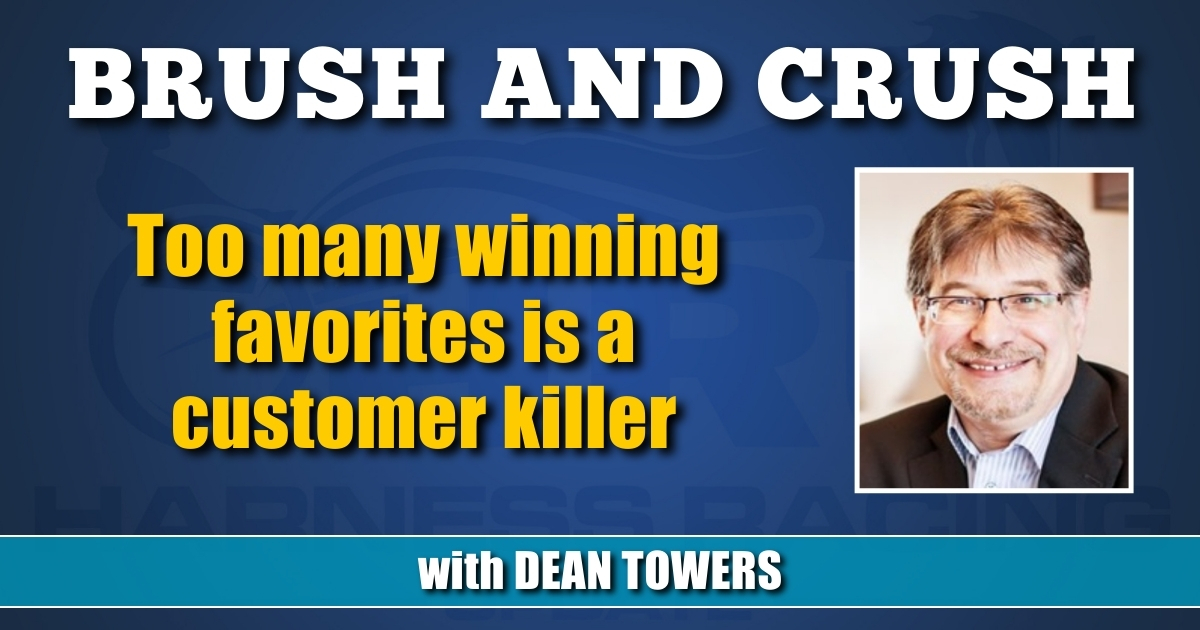Too many winning favorites is a customer killer
by Dean Towers
We hear it time after time: there are too many favorites, harness racing is too predictable, and it’s bad for the game. Are these people all wet, or do they have a point?
Let’s talk some gambling.
We all know a game of coin flip can’t be beaten long term. But there is a way to make this game somewhat attractive. For this 50 per cent proposition, with a one per cent takeout, a $1,000 bankroll and $50 bets (original bet size; five per cent of bankroll ongoing), we can flip a coin 20 times each week for 20 weeks and still mathematically have about $820 of our bankroll left. With that much cash in the kitty many could keep playing, hoping to go on a run.
A casual sports bettor making 20 five per cent bets per weekend with that same $1,000 bankroll for the NFL season plus some playoff games (20 weeks), mathematically will have about $400 of their $1,000 remaining. They can, and do, keep firing.
A craps bettor going to the casino once a week playing a $10 pass line with 3x4x5x odds over an hour (about $1,000 in wagers per session), will have approximately $800 of their $1,000 bankroll remaining after 20 weeks.
Meanwhile in horse racing (at current takeout rates) things are not attractive.If a casual bettor puts $1,000 in an ADW account and makes 20 win bets of five per cent each week over a few racing cards, they would not be able to make a minimum $2 wager at five per cent after 16 weeks. They’d essentially be broke.
Digesting those numbers, why would anyone play horse racing over these other games? That’s easy, and I’m sure you’re screaming it from the rafters. This sport isnota coin flip – there are not only two outcomes in a race.
If you flip on a thoroughbred race from overseas or a deep turf race at Keeneland or Belmont there are many possible winners. For a Kentucky Derby it’s common to see bettors digging into the past performances and liking a dozen horses or more. It’s a huge asset – high takeout rates are somewhat muted when there is more choice.
But what about harness racing? On paper it should be the same. However, with favorite win rates approaching 50 per cent, it turns a game with lots of variance and choice into a game of coin flip. The game’s edge is degraded.
We see this phenomenon more and more in the current speed favoring, slot fueled nature of the sport. Sure, there may be eight horses in a field at Yonkers, but the outside horses are waiting for a better post and there are two likely winners on the inside. Stakes racing is not much better, if at all. We usually have a choice between a 7-5 Burke and a 4-5 Takter, with a whole whack of horses hoping for a check. This is the major reason thoroughbred stakes races attract millions of dollars with ease, while harness stakes races do not.
A couple of weeks ago on these pages, harness racing gamblers discussed why shutting holes might improve the sport, making it more unpredictable and how it may help bring closers into play. You’ve no doubt seen talk about eliminating passing lanes, staggered starting gates, bonuses for winning from outside posts and the like. These ideas (whether good or bad) come from a good place.
Harness racing can’t thrive as a gambling game with an exacta of high takeout and more and more chalk. The fields have to be deeper; the game has to be made more attractive. It’s no grand conspiracy; there are no tin foil hats. It’s just math.

















